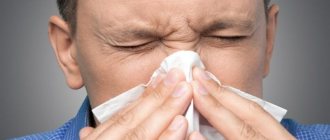Dry and wet cough - important differences
The second name for the pathologies under consideration is non-productive and productive cough. The first form of violation tends to be more complicated. Gradually, the dry type of syndrome turns into a wet form, but this process can take a considerable period of time.
The table below will help you understand dry and wet cough, how to distinguish these symptoms from each other:
| Non-productive syndrome | Wet type of symptom |
| There is no mucus formation process | Mucus is produced in varying amounts |
| Sputum does not leave the respiratory tract | There is a discharge of bronchial secretions |
| Causes hoarseness, chest pain | Leads to shortness of breath, discomfort, wheezing |
| Worsens at night | Occurs periodically throughout the day |
| Present for 2-14 days, sometimes longer | May bother you for at least a month |
Both types of disorders can occur with a rise in body temperature and a runny nose. Sometimes, against the background of pathologies, nausea and vomiting, abnormal salivation, and sleep disturbances develop .
Dry cough is more difficult to treat. Gradually it becomes moist, helping to remove viruses, bacteria or foreign bodies from the body. In the absence of quality treatment, the unproductive syndrome can quickly become chronic and provoke neuroses and heart failure.
If the problem is ignored for a long time, the risk of developing asthma increases - a dangerous disease that causes narrowing of the small bronchi (bronchospasm) and severe attacks.
Dry cough: features
A nonproductive cough is a symptom of many diseases that are infectious or viral in nature (pharyngitis, bronchitis). It can be pressed without mucus separation.
This is due to the fact that when you have a cold, an inflammatory process begins in the larynx and pharynx, which causes a lot of mucus to be produced, which provokes a constant desire to cough. Moreover, sputum is not produced, and the cough is painful, hysterical and very strong.
First, a sore throat appears, followed by a nonproductive cough. Then (after 3-4 days) the dryness goes away, which means that the non-productive cough has become wet, during which phlegm is removed from the body. Afterwards, the process of mucus separation slows down, and it can become dry again.
The following factors contribute to the appearance of a dry cough:
- cigarette smoke;
- allergic reactions;
- influenza (characterized by a hoarse and dry cough, which then becomes wet);
- pleurisy;
- indoor air is too dry;
- pharyngitis;
- chemicals that cause throat irritation (solutions, paints);
- tracheitis.
In addition, a dry periodic cough may indicate the presence of infectious diseases such as measles, whooping cough (with whistling and spasming) and laryngitis (barking and dry). In addition, a nonproductive cough that occurs with false croup (swelling of the larynx and trachea) is considered quite dangerous.
Depending on the factor that causes the protective reflex, this phenomenon can occur at different times of the day. His character can be annoying, barking without mucus. Moreover, it can be debilitating and millet-like.
With a nonproductive cough, the patient wants to cough up, but the doctor does not advise doing so. Because the vocal cords will be overstrained, after which hoarseness or loss of voice may occur.
It is worth noting that with this type of cough, inflammation develops in the body and irritation of the respiratory organs occurs. Therefore, it is necessary to carry out treatment aimed at making him productive.
Why does pathology occur?
Unproductive cough syndrome most often manifests itself against the background of various diseases:
- rhinitis;
- laryngitis;
- acute viral pathologies of the upper and lower respiratory tract;
- bronchial asthma;
- sinusitis.
If coughing is not accompanied by complete discharge of sputum, the reasons for this may be prolonged inflammation in the nasopharynx or allergies. In young children, pathology can occur after small foreign objects enter the respiratory tract.
In adults, a dry cough often occurs as a result of prolonged smoking. It is sometimes considered a side effect of therapy with certain medications.
It is important to know! Unproductive syndrome does not necessarily manifest itself in diseases of the respiratory system. In some cases, it is recorded against the background of gastric, cardiac, and liver pathologies.
A wet cough can develop in a person who has:
- bronchitis;
- ARVI;
- flu;
- pneumonia;
- tuberculosis.
The symptom worries people who have certain features in the structure of the respiratory organs. In addition, it is typical for it to appear during a sharp change in temperature.
Unlike the dry type of syndrome, the productive type of disorder does not occur due to allergic reactions. It also does not tend to develop due to diseases that do not affect the respiratory system.
What is the difference between a dry allergic cough and a dry cold cough?
Cough duration is usually classified as follows:
- acute – up to 2 weeks;
- protracted – from 2 to 4 weeks;
- subacute – from 4 to 8 weeks;
- chronic – more than 2 months).
Depending on whether sputum is produced, the cough is divided into:
- dry (unproductive) – sputum is not separated;
- wet (productive, wet) – sputum is separated.
https://www.youtube.com/watch?v=OsTBaiBNwIg
It is possible to diagnose dry and wet cough in children and adults without prior preparation.
In this case, you will have to rely on the coughing sensations, as well as your own hearing.
For wet type:
- There is wheezing in breathing. They arise due to the movement of sputum.
- After coughing, a lump of mucus forms in the throat, which you want to spit out or swallow. Sputum discharge is the main sign by which it is determined whether a person has a dry or wet cough.
- The productive type causes a feeling of relief after an attack. It becomes easier to breathe, and the urge to cough again occurs after a few minutes. During the rest period, there is no sensation of scratching in the throat if there is no inflammation there.
How to recognize dry type:
- Similarity to barking - by this sign you can recognize the type of cough by ear.
- The absence of sputum is a key sign by which non-medics can distinguish between the two types of cough.
- After the attack, the feeling of a sore throat occurs again. There is no way to stop, the attack lasts several minutes. In severe cases, the process stops only after fainting due to the inability to breathe normally during the attack.
Pediatricians tell parents how to determine what type of cough a child has. However, a preliminary consultation with a doctor does not guarantee an accurate self-diagnosis. This is due to poorly formed reflexes in a child two years old or younger.
A child should not self-medicate, since most pharmaceutical drugs are contraindicated under the age of 3 years.
A wet (wet) cough in most cases appears after a dry one. The main reason is the accumulation of sputum in the tracheobronchial tree, as well as in the lungs. Doctors call it productive because it helps remove mucus from the lungs, which is an ideal environment for the proliferation of harmful microbes.
To enhance coughing, sputum must be diluted using special drugs - mucolytics. They have a combined effect: they reduce the thickness of sputum and help speed up its removal from the body. A wet cough, unlike a dry cough, brings tangible relief to a person. In addition, the result is obvious - in the form of expectorated sputum.
There are several distinctive features:
- After the end of a coughing attack, a person feels a clot of mucus rising from the bronchi in the mouth and the desire to spit it out.
- Immediately before a coughing attack, a person again feels that mucus has accumulated. This is precisely why the desire to cough appears.
- At rest or during sleep, wheezing is heard. In some cases, shortness of breath may occur.
If coughing attacks occur frequently enough, they can cause pain in the abdomen and back. If, while coughing, a person cannot expectorate phlegm, there is a risk of it getting into the stomach. In some cases, this can lead to nausea and vomiting.
It is not recommended to suppress cough attacks, because with their help the body is cleansed of harmful contents of the respiratory tract. It should be treated with expectorants. To get rid of a wet cough as quickly as possible, you need to do inhalations and be sure to increase the volume of fluid you drink.
If you start coughing, but are not sure that you have a cold, you should think about the allergic nature of your cough. How can you tell: is this a symptom of a cold or an allergy? An allergic reaction can be recognized by the following signs:
- Cough attacks are debilitating. Sometimes it seems that it is simply impossible to clear your throat completely. The reason is irritation of the bronchial mucosa by some allergen and swelling of the larynx. A person cannot breathe fully. In addition, there is no sputum, and there is no relief after the attack.
- During a coughing attack, a person experiences a lack of air. Choking may occur, accompanied by fear and even panic.
- The allergic reaction occurs without headache, fever and chills (all these symptoms are characteristic of a cold).
- The cough may be accompanied by watery eyes, rhinitis and skin reactions.
- The ability to increase under certain conditions. For example, if an irritant appears nearby (the aroma of perfume, the hair of a pet, and so on).
- It is seasonal (spring hay fever).
- Conventional cough suppressants do not help. But antihistamines are effective.
In children, it comes with nasal itching, rhinitis, sneezing and difficulty breathing. Its main difference from a cold is that the body temperature remains within normal limits.
If you constantly cough after contact with any substance, this is a 100% allergy. But if you cannot say for sure what irritant provoked the allergic reaction, you will need to carry out diagnostics and identify it.
Cough is a natural reflexive response of the respiratory organs to irritation of sensitive mucous membranes. A sharp contraction of muscles leads to a push and an uncontrolled release of air from the lungs.
This is not an independent disease, but only a symptom that helps the body clear the airways of mucus, fluid and pathogenic microorganisms. To choose the optimal treatment for the underlying disease, you need to know how to distinguish a dry cough from a wet one.
The purpose of a cough is to rid the airways of harmful elements that irritate the mucous membrane. Germs, bacteria and dust particles enter the sputum, which is secreted by the bronchi. If a reflex muscle contraction leads to the removal of mucus out, the body is cleansed and the cough is considered productive.
The difference between dry and wet cough is that the first type is characterized by inflammation, but the removal of mucus from the bronchi does not occur. The lack of sputum negatively affects the condition of the mucous membrane: constant spasms irritate the larynx. The process is not productive and does not bring any benefit.
Various viral and infectious diseases begin with a dry cough. The inflammatory process develops quite quickly, and after a few days mucus should begin to be released.
Productive cough medications are needed to quickly clear mucus from the airways.
Nonproductive cough is often caused by:
- viruses;
- allergies;
- laryngitis;
- dry pleurisy.
A wet cough can be constant or intermittent. The color of the discharge indicates the progress of the disease. With proper treatment, the sputum becomes clear. If it is green or yellowish, this is a reason to consult a doctor: perhaps the inflammatory process in the respiratory system has worsened.
The severity of symptoms and the frequency of attacks depend on the nature and speed of development of the underlying disease.
A wet cough is considered a productive form, since it is accompanied by active sputum production and helps the body fight viral inflammation. During it, particles of dirt and dust that a person inhales during the day are also removed. A nonproductive cough is dry: it does not help clear the airways, but irritates the larynx.
What distinguishes the types of coughs is the mechanism of their formation. Dryness is often the first symptom of the onset of a viral disease. First, the inflammatory process is based in the area of the nasopharynx and larynx. When the infection enters the upper respiratory tract, sputum appears in the bronchial tree.
An intermediate option is an unproductive cough. It is possible if mucus that is too viscous appears in the respiratory tract and cannot be coughed out. In this case, auxiliary drugs are needed.
They dilute mucus and promote its rapid removal from the patient’s body.
Without the removal of sputum, the body is unable to get rid of pathogenic microorganisms, which is why coughing attacks become violent and are accompanied by severe chest spasms, irritation of the nasopharynx and pharynx. The injured mucous membrane becomes defenseless against infections.
You can determine whether a cough is dry or wet after an attack: when it is wet, the mucus is coughed up and remains in the patient’s mouth. The process is not accompanied by painful sensations, and the accumulation of sputum is felt even before the cough begins. During it, obvious wheezing is heard.
Knowledge of the main features of the nonproductive reflex helps to distinguish a dry cough from a wet cough in an adult. These include:
- Sudden attacks without preliminary urges.
- Trouble breathing while coughing.
- Chest pain.
- There is no relief after coughing.
- Barking sounds.
- Burning and pain in the throat.
Severe irritation and narrowing of the larynx leads to a reaction of the esophagus, which is why prolonged bouts of unproductive dry cough often lead to vomiting.
You need to know the difference between a dry cough and a wet cough in adults in order to choose the right treatment.
Medicines with a mild anesthetic effect can also be used: they reduce the sensitivity of the mucous membrane, relieving the patient of the desire to cough.
For wet coughs, reflex suppressors, with the exception of certain cases, are prohibited: they only complicate the process of cleansing the body. Only expectorants that restore the functions of the respiratory tract and eliminate phlegm from the bronchi and lungs are suitable.
Differences in a child
Young children often cannot explain to their parents what sensations they experience. Adults should know how to distinguish a dry cough from a wet cough in a child: they should press their ear to the chest and ask the baby to breathe through his mouth for a while. If gurgling and wheezing are heard, it means the cough is wet.
Which syndrome is more dangerous?
The greatest danger is present during severe attacks of dry cough. This condition is accompanied by severe irritation that occurs in the nose and throat.
If coughing causes significant strain, hemorrhages occur in the organs of vision. Sometimes ear congestion occurs. With a tendency to frequent increases in blood pressure, an ongoing syndrome can provoke an exacerbation of hypertension and a significant deterioration in well-being.
Progressive pathology can be accompanied by spasms, vomiting, and loss of consciousness. With this form of disorder, the patient requires accelerated liquefaction of sputum and effective stimulation of its discharge.
Treatment options
When a syndrome appears, it is important to accurately determine its type. Only after this can you begin to treat cough, based on the use of pharmaceutical drugs and folk remedies.
Dry cough therapy
To cure non-productive syndrome, the following types of medications are used:
- mucolytics;
- antitussive medications;
- combined means.
Mucolytics include drugs that cause an accelerated transition of an unproductive symptom into a wet form. The main effect of medications is to liquefy viscous sputum. Among such drugs, Bromhexine, Ambroxol, ACC, Mucaltin, and licorice root syrup are effective.
Antitussives help relieve painful cough syndrome by acting on certain parts of the brain and inhibiting the cough reflex. Drugs from this group are represented by narcotic and non-narcotic products - Codeine, Libexin, Omnitus, Levopront.
Combination drugs for dry cough consist of several active components. Such medications provide dilution and removal of accumulated mucus, eliminate the inflammatory process, improve the general well-being of the patient and replenish vitamin deficiencies in the body. This category of medications is represented by Stoptussin, Halixol, Broncholitin.
Medicines for cough syndrome have a variety of release forms. For adults and adolescents, tablets or capsules are suitable. Syrups and suspensions are recommended for children .
Wet cough remedies
Treatment of productive cough syndrome is carried out with the help of drugs that have expectorant properties. Such drugs cause faster evacuation of mucus from the bronchi and lungs, and also restore their normal functioning.
Therapy is often based on the use of:
- Bromhexine;
- Fluimucil;
- Bronchosana;
- Fluditeca;
- Libexina Muco.
Modern pharmacological companies also produce drugs prescribed to patients who have a dry and wet cough at the same time. These products include Doctor MOM, Joset, Stodal, Flavamed.
In addition to pharmacological products, non-traditional methods are widely used in the treatment of the syndrome. It is recommended to get your doctor's approval before using them.
All folk remedies for cough include completely natural ingredients and are suitable for use even in early childhood.
How to treat dry cough?
If timely treatment is not carried out, this symptom will become chronic. But first, it is important to consult a doctor who will prescribe synthetic (chemical-based) or natural (plant-based) products.
All drugs are divided according to the principle of their effect on:
- expectorants – dilute mucus and then remove it from the respiratory organs;
- antispasmodic or antitussive - eliminate spasms and soothe;
- products containing natural ingredients act gently, without side effects.
Dry coughs are treated with antitussives, and wet coughs are treated with drugs that have an expectorant effect. At the same time, cough medicines soothe the mucous membranes of the larynx and pharynx, removing spasms in the bronchi. Such means are:
- Gerbion (plantain-based syrup);
- Libexin;
- Tusuprex;
- Stoptussin.
In case of severe manifestations, drugs that relieve the cough reflex can be prescribed, but they can only be used for a short time. These drugs have peripheral and central effects, these include Glaucine, Codeine and Ethylmorphine.
Prevention of violation
The risk of developing cough syndrome can be reduced thanks to traditional preventive measures:
- Timely treatment of colds.
- Avoiding hypothermia.
- Good nutrition.
- Proper hardening of the body.
- Regular medical examinations and fluorography.
- Quitting smoking.
- Annual immunization against influenza and pneumonia.
- Maintain good personal hygiene, frequent hand washing.
Dry and wet coughs can bother both adults and children. To prevent these pathologies from developing into serious diseases, it is important to consult a doctor at the first signs of deterioration in health, and also avoid the use of questionable medications.
Our materials will be useful for you and other users. Share the article on social networks! Click!










